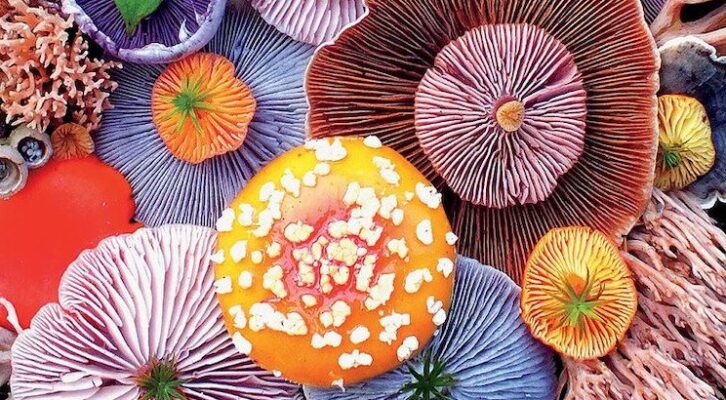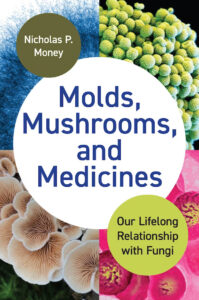
Magic and Medicinal: On the Pharmacological Potential of Mushrooms
Nicholas P. Money Considers the Role of Fungi in Treating the Body and the Mind
A few years ago, I published an article titled “Are Mushrooms Medicinal?” in the journal Fungal Biology, which was downloaded more than any previous paper in the history of the periodical. Supportive emails arrived from fellow scientists, but a much larger number of messages questioned my intelligence and motives. One critic asked, “Did you even do a lit review on the topic before you wrote this paper?” and continued, “It just seems like you’re being willfully ignorant, intentionally misleading, or have an interesting criteria [sic] for what constitutes validity.” My criteria [sic] is, show me the evidence, which is codified in Hitchens’s razor, or epistemological rule, authored by the late journalist Christopher Hitchens: “What can be asserted without evidence can also be dismissed without evidence.”
A search for “shiitake” combined separately with each of the following illnesses and health conditions starting with the letter a: acne, AIDS, Alzheimer’s disease, anthrax, arthritis, asthma, and autism. Shiitake is endorsed as a treatment for all of them. Pick a different letter and see for yourself. Inspired by Mr. Hitchens, I offer my own razor: A cure alleged for everything is an effective treatment for nothing.
Belief in the baseless powers of medicinal mushrooms may also be strengthened by the widespread skepticism toward medical authority.
By deifying shiitake and other species of fungi, the medicinal mushroom magicians—the champions of champignons—betray themselves as con artists to anyone willing to ask a few questions. Some of these latter-day shamans are deliberate scammers, others know no better, and I am aware that I am howling at the moon. Belief in the baseless powers of medicinal mushrooms may also be strengthened by the widespread skepticism toward medical authority.
All of this is unfortunate for the study of mycology because mushrooms are probably brimming with undiscovered medicines that might be developed using modern pharmacological methods. Why then, one might ask, has there been such a rich history of drug discovery in plants, while most of the woodland fungi have been ignored? Aspirin, ephedrine, opiates, and quinine were used by herbalists in the form of unrefined preparations from plants for thousands of years before any attempts at purification. The historical success of these plant extracts in medicine argues for a similar impact of mushrooms, but confusion about their nature (“these bastard plants, or excrescences”) and toxicity (“some are very venomous and full of poison”) meant that they were neglected by the great herbalists of Europe.
While mushroom medicine has gone nowhere, the yeast used for brewing and baking has transformed the pharmaceutical industry as an infinitely pliable platform for drug production. Ordered to make human insulin using the human gene, yeast complies and produces half of the global supply of injectable insulin to combat diabetes. Modified with a DNA sequence from the human papilloma virus (HPV), yeast translates this into copies of the protein that forms the shell of the viral particle. Separated from the yeast, this protein is injected as a vaccine against HPV, which has the potential to eliminate the form of cervical cancer linked to this infection.
Another medicine from genetically modified yeast is used to treat an age-related eye condition, and there is a lot of research on using yeast cells to synthesize painkillers. When we consider antibiotics from molds and all these drugs manufactured by yeast, it is evident that fungi are an indispensable source of modern medicines. To add new compounds from fungi to the pharmacy, we need to bring the chemistry of mushrooms into the mainstream.
Meanwhile, magic mushrooms light up the brain like fireflies in a meadow. Waves of nerve activity rise, crest, and dissolve from spot to spot across the brain, with islands of impulses crackling here, dampening there, as consciousness is disconnected from the usual flow of information. The brainwaves on mushrooms are similar to those in intense dreaming, with the twist that the temporary uncoupling from everyday thinking via the mushroom can have a lasting effect on our mindset when we reconnect. Anxiety and depression can lose some of their bite; life can seem less brutish. A mushroom dream is like a vacation to a tropical island or a canoeing trip along a pristine river, with the surprising benefit that the peace found during the break stays with you when it is over.
After decades of scientific neglect, psilocybin has become a subject of intensive research, and some broad consensus is emerging on some of the neurological processes that govern the mushroom dream. Electrical impulses are conveyed along neurons through the movement of charged atoms or ions across their membranes. When these signals reach the end of the cells, they cause the release of chemical neurotransmitters that stimulate or block the generation of fresh impulses in the next neurons in the circuit. Serotonin is one of the neurotransmitters that perform this slower relay of sparks from cell to cell.
When we consume psilocybin, a chemical group projecting from the ring structure of this little molecule is trimmed away in the liver, producing psilocin. The structure of the psilocin molecule is so similar to serotonin that it undoes the normal transmission of nerve impulses between cells. Serotonin performs multiple roles in human physiology, ranging from the control of the unconscious process of digestion to the conscious emotion of happiness. If too much is released in the nervous system, the body responds with agitation and muscle cramping; too little and we lose motivation and can descend into depression.
In the search for relief from depression and anxiety, it is useful to consider why deep unhappiness is so prevalent.
Physical symptoms produced by the use of psilocybin result from the stimulation and repression of neural networks that normally respond to serotonin and include increases in heart rate and blood pressure, sweating, muscle twitching, facial numbness, nausea, lack of coordination, and headaches. These begin about twenty minutes after eating the mushrooms, differ greatly from person to person, and are usually mild. If we did not favor the uplifting psychological effects of psilocybin, these reactions would be seen as expressions of mushroom poisoning. Not on a par with the death cap, of course, but poisoning nevertheless, which is why many mushroom guides place a skull and crossbones symbol next to entries for Psilocybe species that contain the drug.
The psychological effects of psilocybin are similarly diverse. Some brain circuits are aroused and become overloaded with information while other parts of the brain are pushed into a dreamlike state. These changes in brain activity are visualized in patients who lie with their head inside the giant donut of a magnetic resonance imaging or MRI machine after they have consumed purified psilocybin. MRI experiments show cross-talk between parts of the brain that normally work in isolation, a reduction in blood flow to areas involved in logical thinking, and an increase in nervous activity in the deeper parts of the brain that control our emotions.
More frequently, our sense of individuality or ego dissolves, which leads to impressions of harmony and kinship with the rest of nature. Ego is lost when psilocin interferes with a brain circuit called the default mode network, or DMN. The DMN is concentrated in the prefrontal cortex and connects with hubs of neurons nestled farther back and deeper in the brain. Our sense of self is maintained in the DMN, and this is where the mushroom subverts our narcissistic programming.
Imagine you are a passenger on a cruise ship that strikes an iceberg. In the seconds following the collision, normal activity in your DMN is suspended while other parts of the brain gather the information needed to figure out what has happened and plan a response. You are too frantic at that moment to be aware that you have raced onto the deck wrapped in a towel and wearing a shower cap. Ego has departed, albeit temporarily.
Later, when it has become clear that the ship is sinking and that the lifeboats have left without you, the DMN has the last word as you resume contact with your sense of self, remove the shower cap, and are flooded with anxiety. Any feeling of positivity would be welcome in this hopeless situation, and this is where mushrooms can become our saviors. If you had swallowed a baggie of them when the ship’s hull was ripped open, the psilocin would have disengaged the DMN from the alarming messages flowing from elsewhere in the brain, pushing you into a dreamlike state and leaving you more philosophical about the prospect of the frigid water.
The soothing effect of magic mushrooms on passengers on a sinking ship is a matter of conjecture, but there is plenty of evidence that psilocybin can reduce our fearfulness in less dramatic situations. Multiple studies have shown that psilocybin is a useful treatment for clinical depression and can even foster a sense of well-being in patients with terminal illnesses. In a trial conducted at Johns Hopkins University in 2016, patients with life-threatening cancer diagnoses reported feelings of greater life satisfaction after receiving high dosages of the drug. These improvements in attitude were sustained in 80 percent of the participants six months after their treatment.
In the search for relief from depression and anxiety, it is useful to consider why deep unhappiness is so prevalent. As imperfect products of evolution, there must be a natural imperative at work. Psychologists have wrestled with this question for decades, and although there is no completely satisfying answer, depression seems to emerge from a combination of bad wiring and the cryptic advantages of wariness, self-doubt, and sadness.
The bad wiring is strung between the more primitive lizard brain and the outermost cortex, where our consciousness and sense of self interact with the primal urges to feed, escape, attack, and copulate. Mild depression might be useful if it provides us with the opportunity to ruminate on a problem and reach a solution, but deep relentless depression has no purpose. In his study of depression titled The Anatomy of Melancholy, Robert Burton (1577–1640) wrote, “What cannot be cured must be endured.” Mushrooms offer an alternative.
__________________________________

Text from Molds, Mushrooms, and Medicines: Our Lifelong Relationship with Fungi by Nicholas P. Money. Copyright © 2024 by Princeton University Press. Reprinted by permission of Princeton University Press.
Nicholas P. Money
Nicholas P. Money is professor of biology at Miami University in Ohio and the author of many books, including The Rise of Yeast: How the Sugar Fungus Shaped Civilization, Mushrooms: A Natural and Cultural History, and Microbiology: A Very Short Introduction.



















